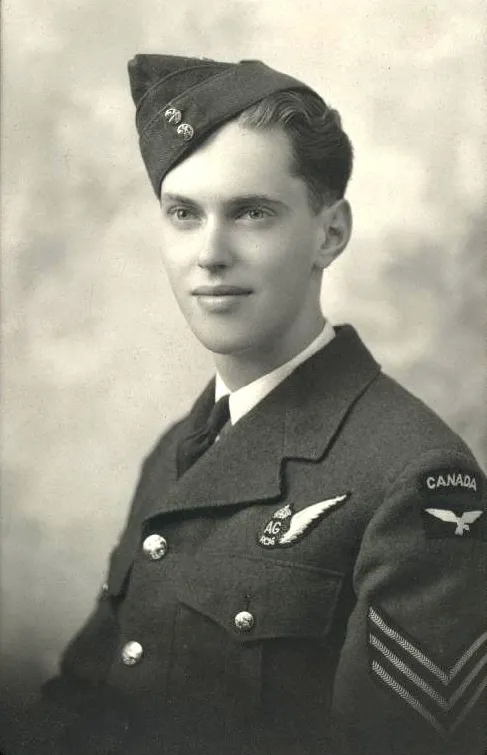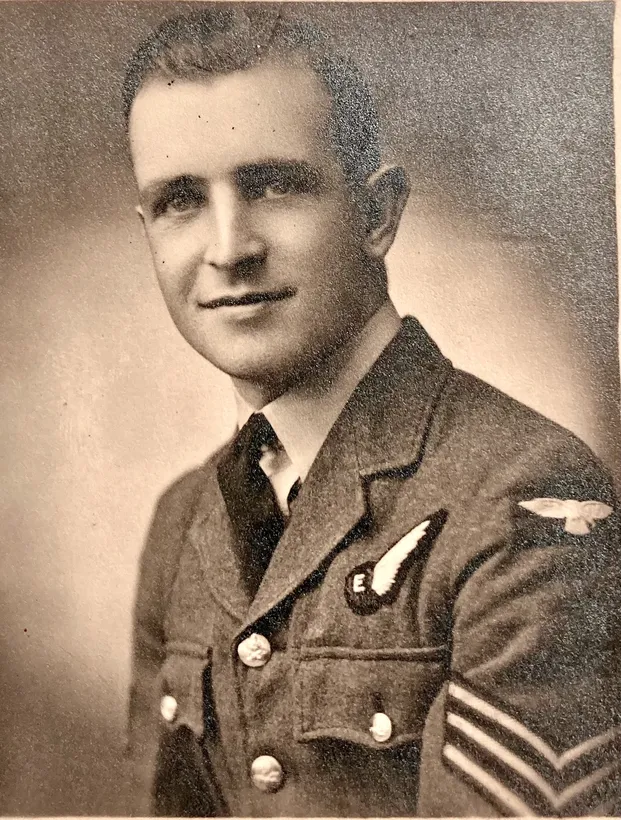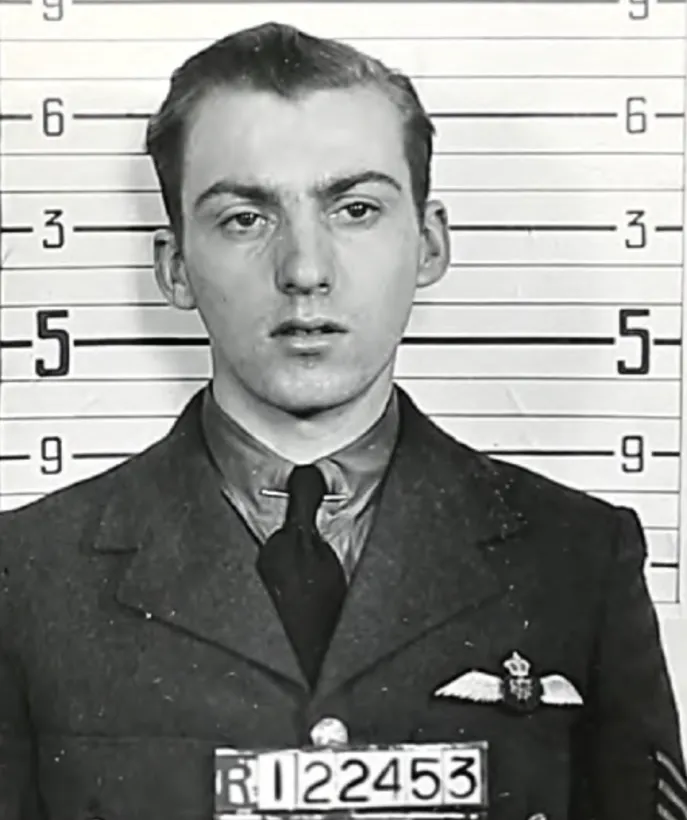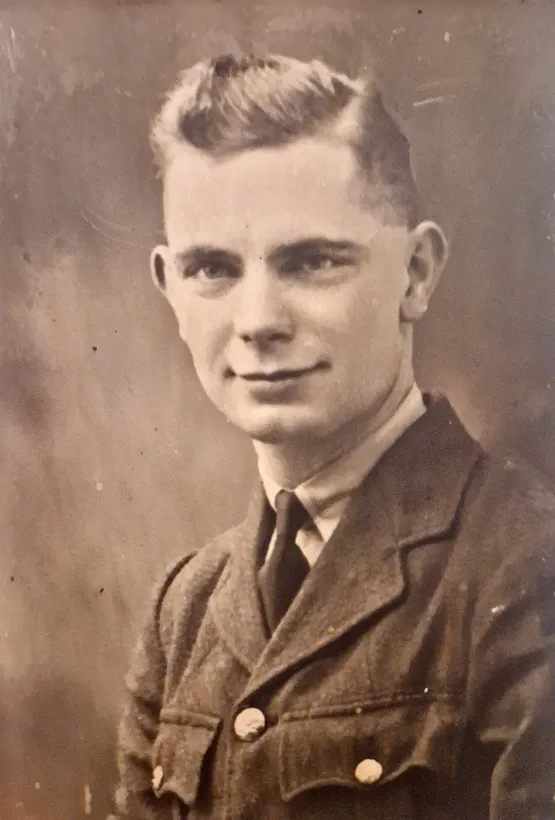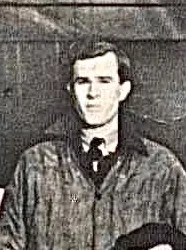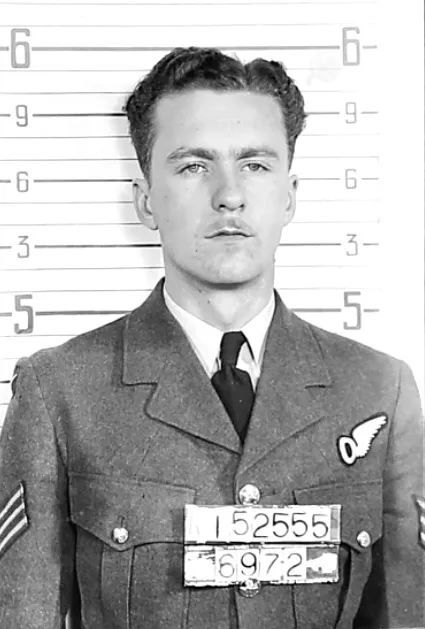Bourcier, Joseph Hector Jean Paul (Flying Officer)
Prisoner of War 1944-April-21
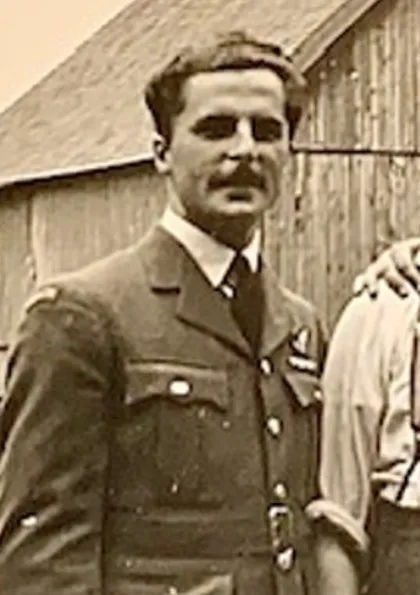

Birth Date: 1921-September-24
Born:
Parents: Son of Alexandre and Eda Bourcier of Chateauguay Quebec
Spouse:
Home: Chateauguay, Quebec
Enlistment:
Enlistment Date: unkown date
Service
RCAF
Unit
420 (B) Sqn- Squadron
Pugnamus Finitum We fight to the finish
Base
RAF Tholthorpe
Rank
Flying Officer
Position
Mid Upper Gunner
Service Numbers
J/86241
PoW: 4179
Home
Target
Crew or Other Personnel
Halifax LW692
Mission
Halifax B/A.Mk.III LW692
Bombing Lens France 1944-April-20 to 1944-April-21
420 (B) Sqn (RCAF) Tholthorpe Yorkshire UK
Aircraft was off course, over Dieppe, which was a heavily defended German naval port. It was expected to cross into France near Le Havre, not Dieppe. Aircraft was shot down by flak en route to attack the rail junctions at Lens, France, crashing into the marsh surrounding Scie River, Pourville-Sur-Mer, Dieppe, France. Wheelhouse, Anderson and Bourcier baled and landed just offshore. Wheelhouse drowned, Anderson and Bourcier were taken Prisoners of War. Wilson's parachute failed to open.
Leonard, Gough and Warren were missing, presumed killed. They are commemorated on the Runnymede Memorial.
An excavation of the crash site began in 2022. Original research by Bill Anderson Winnipeg
Halifax serial: LW692

The Handley Page Halifax is a British Royal Air Force (RAF) four-engined heavy bomber of the Second World War. It was developed by Handley Page to the same specification as the contemporary twin-engine Avro Manchester.
The Halifax has its origins in the twin-engine HP56 proposal of the late 1930s, produced in response to the British Air Ministry's Specification P.13/36 for a capable medium bomber for "world-wide use." The HP56 was ordered as a backup to the Avro 679, both aircraft being designed to use the underperforming Rolls-Royce Vulture engine. The Handley Page design was altered at the Ministry to a four-engine arrangement powered by the Rolls-Royce Merlin engine; the rival Avro 679 was produced as the twin-engine Avro Manchester which, while regarded as unsuccessful mainly due to the Vulture engine, was a direct predecessor of the famed Avro Lancaster. Both the Lancaster and the Halifax would emerge as capable four-engined strategic bombers, thousands of which would be built and operated by the RAF and several other services during the War.
On 25 October 1939, the Halifax performed its maiden flight, and it entered service with the RAF on 13 November 1940. It quickly became a major component of Bomber Command, performing routine strategic bombing missions against the Axis Powers, many of them at night. Arthur Harris, the Air Officer Commanding-in-Chief of Bomber Command, described the Halifax as inferior to the rival Lancaster (in part due to its smaller payload) though this opinion was not shared by many of the crews that flew it, particularly for the MkIII variant. Nevertheless, production of the Halifax continued until April 1945. During their service with Bomber Command, Halifaxes flew a total of 82,773 operations and dropped 224,207 tons of bombs, while 1,833 aircraft were lost. The Halifax was also flown in large numbers by other Allied and Commonwealth nations, such as the Royal Canadian Air Force (RCAF), Royal Australian Air Force (RAAF), Free French Air Force and Polish forces. Wikipedia
Unit Desciption
420 (B) Sqn Pugnamus Finitum ("Snowy Owl")
History of the Squadron during World War II (Aircraft: Hampden I, Wellington III, X, Halifax III, Lancaster X)
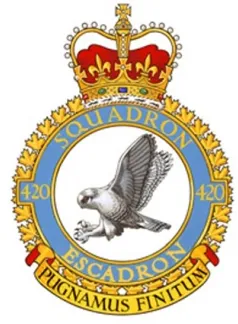
420 Squadron RCAF was the fourth RCAF bomber unit formed overseas in WWII. It was formed at Waddington, Lincolnshire, UK ![]() on December 19, 1941 as a unit of No 5 Group of RAF Bomber Command flying Handley Page Hampden Mk 1 aircraft, with the squadron code letters PT. In early August 1942 the squadron transferred to No 4 Group of Bomber Command, and was based at Skipton-on-Swale, Yorkshire
on December 19, 1941 as a unit of No 5 Group of RAF Bomber Command flying Handley Page Hampden Mk 1 aircraft, with the squadron code letters PT. In early August 1942 the squadron transferred to No 4 Group of Bomber Command, and was based at Skipton-on-Swale, Yorkshire ![]() : at this time it was equipped with Vickers Wellington Mk. III aircraft. In October 1942 it moved to Middleton St. George, Durham
: at this time it was equipped with Vickers Wellington Mk. III aircraft. In October 1942 it moved to Middleton St. George, Durham ![]() , where on January 1, 1943 it became a unit of the newly-created no. 6 (RCAF) Group of Bomber Command. It remained there until May 1943, when, by now flying tropicalized Wellington Mk X aircraft, it flew to Tunisia in North Africa to join No 331 (RCAF) Wing of No. 205 Group. From the bases of Kairouan/Zina
, where on January 1, 1943 it became a unit of the newly-created no. 6 (RCAF) Group of Bomber Command. It remained there until May 1943, when, by now flying tropicalized Wellington Mk X aircraft, it flew to Tunisia in North Africa to join No 331 (RCAF) Wing of No. 205 Group. From the bases of Kairouan/Zina ![]() and Hani East Landing Ground
and Hani East Landing Ground ![]() (both locations approximate)it attacked targets in Sicily and Italy as part of the invasion force. In October, the squadron returned by sea to England, leaving its aircraft behind, and rejoined 6 Group at Dalton, Yorkshire, re-equipping with Handley Page Halifax Mk. III aircraft. The squadron finally moved to Tholthorpe, Yorkshire
(both locations approximate)it attacked targets in Sicily and Italy as part of the invasion force. In October, the squadron returned by sea to England, leaving its aircraft behind, and rejoined 6 Group at Dalton, Yorkshire, re-equipping with Handley Page Halifax Mk. III aircraft. The squadron finally moved to Tholthorpe, Yorkshire ![]() in December 1943, where it remained until the end of hostilities in Europe. From April 1945 the squadron re-equipped with Lancaster Mk. X aircraft, although they were not used operationally. In June 1945 the squadron flew its aircraft to Debert, Nova Scotia
in December 1943, where it remained until the end of hostilities in Europe. From April 1945 the squadron re-equipped with Lancaster Mk. X aircraft, although they were not used operationally. In June 1945 the squadron flew its aircraft to Debert, Nova Scotia ![]() , where it disbanded in September of 1945
, where it disbanded in September of 1945
In the course of hostilities, the squadron flew 4186 sorties for the loss of 65 aircraft. 9771 tons of bombs were dropped. The squadron won 38 DFC's, 1 Bar to DFC, and 9 DFM's. Battle Honors were: English Channel and North Sea 1942-44, Baltic 1942, Fortress Europe 1942-44, France and Germany 1944-45, Biscay Ports 1942-44, Ruhr 1942-45, Berlin 1944, German Ports 1942-45, Normandy 1944, Rhine, Biscay 1942-43, Sicily 1943, Italy 1943, SalernoWikipedia, Kostenuk and Griffin, Moyes
![]() 420 Squadron History (Bomber Command Museum (Large PDF)
420 Squadron History (Bomber Command Museum (Large PDF)
![]() 420 Tholthorpe Airfield Operations Record Book
420 Tholthorpe Airfield Operations Record Book
![]() 420 Squadron Operations Record Book
420 Squadron Operations Record Book
Maps for Movements of 420 Squadron 1941-45
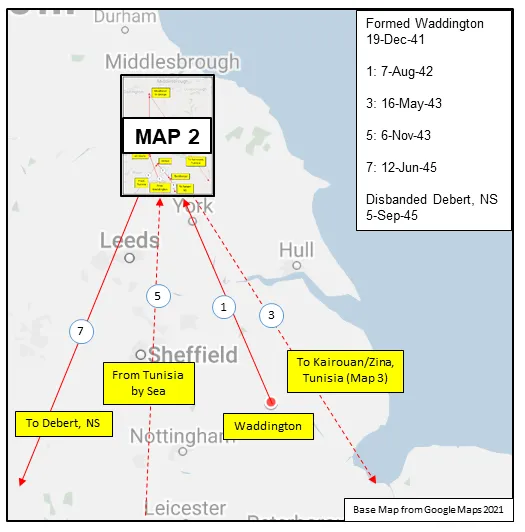
MAP 1: 420 Squadron Movements in England 1941-45 (right-click on image to display enlarged new tab)
|
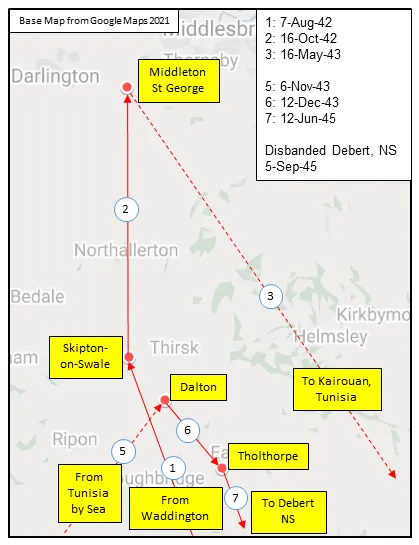
MAP 2: 420 Squadron Movements in Yorkshire and Durham 1942-45
|
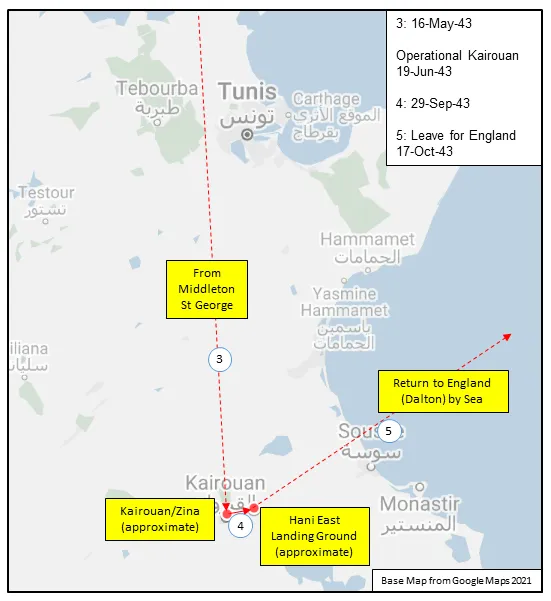
MAP 3: 420 Squadron Movements in Tunisia, North Africa 1943
|
420 Squadron History Summary 1941-45
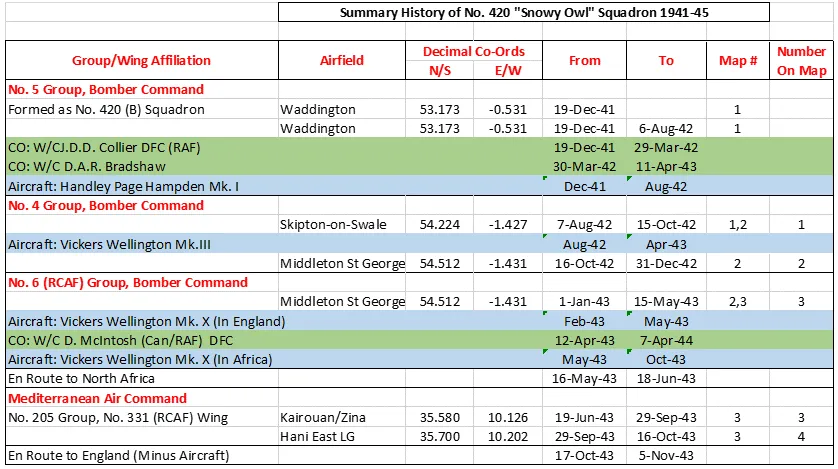
420 Squadron History Summary 1941-45 Page 2
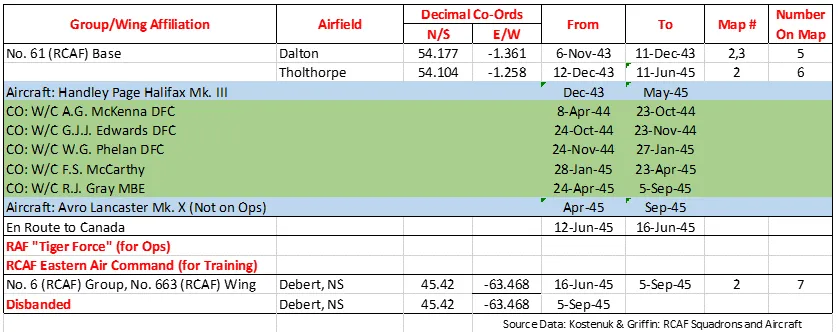
History of the Squadron Post-WWII (Aircraft: Harvard, Mustang, Silver Star, Tracker)
No. 420 Squadron reformed at London, Ontario ![]() on 15 September 1948, and flew North American Mustang and Harvard aircraft in a fighter role until the squadron disbanded on 1 September 1956. The squadron was re-formed as an Air Reserve squadron based initially at CFB Shearwater, Nova Scotia
on 15 September 1948, and flew North American Mustang and Harvard aircraft in a fighter role until the squadron disbanded on 1 September 1956. The squadron was re-formed as an Air Reserve squadron based initially at CFB Shearwater, Nova Scotia ![]() flying the de Havilland Canada Tracker aircraft that had once been the backbone of the Canadian Naval Air's anti-submarine program. As an Air Reserve Squadron it participated with regular fisheries patrols. It was one of the few active Air Reserve Squadrons in Canada and was paired with the Regular Force's 880 Squadron. The Squadron was rebased to CFB Summerside, Prince Edward Island
flying the de Havilland Canada Tracker aircraft that had once been the backbone of the Canadian Naval Air's anti-submarine program. As an Air Reserve Squadron it participated with regular fisheries patrols. It was one of the few active Air Reserve Squadrons in Canada and was paired with the Regular Force's 880 Squadron. The Squadron was rebased to CFB Summerside, Prince Edward Island ![]() when their base was downsized. No 420 Squadron was reduced to nil strength on 15 May 1995.
when their base was downsized. No 420 Squadron was reduced to nil strength on 15 May 1995.
Supplemental Story
Author and Dedication
This history of Pilot Officer Robert Allan Anderson has been assembled by his son Bill Anderson and was submitted to the Canadian Warplane Heritage Museum in November 2020. Robert Allan Anderson was a Sergeant at the time of the crash. Bill Anderson's research used original source materials from the RCAF, his father's journals plus direct explanations from his father. Bill also credits veteran pilot of 420 Squadron and author, Russell McKay, in assisting him, and for the title My Dad's War.
With respect to the title "My Dad's War", I had sent the following letter and information to Russell and in the following May 23, 2009 letter to me, he remarked "Dear Mr. Anderson: I thank you for the huge amount of extremely interesting WW II information pertaining to your Father and his war". When I read those words, I immediately understood what the title of my Dad's story must be!
![]() Letter to Russell McKay from Bill Anderson
Letter to Russell McKay from Bill Anderson
![]() Letter From Russell McKay to Bill Anderson
Letter From Russell McKay to Bill Anderson
LW692 Crew - April 20, 1944
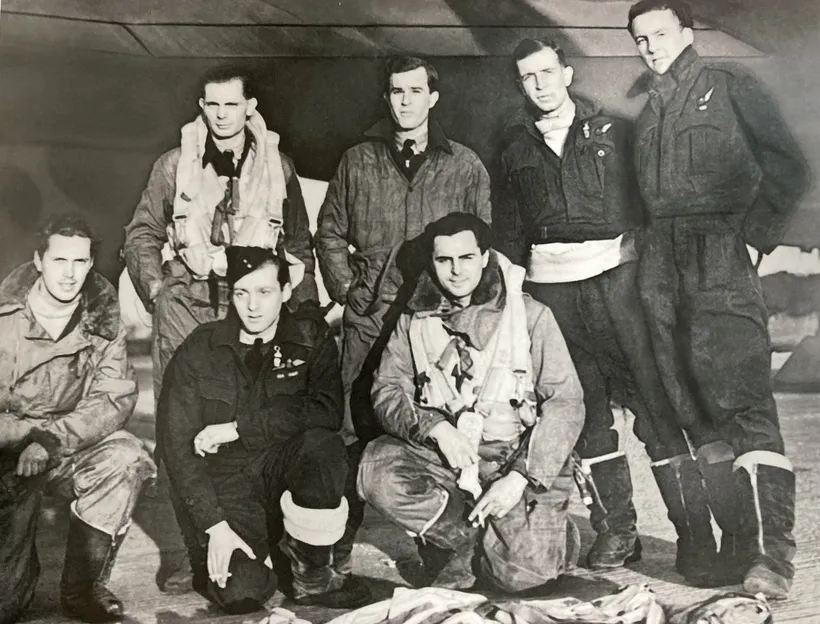
Sergeant Alfred Warren (RAF) Navigator | Sergeant Clifford Wheelhouse (RAF) Wireless Air Gunner
Sergeant Patrick Gough (RAF) Flight Engineer | Sergeant Clarke Wilson (RCAF) Bomb Aimer
Front row left to right:
Sergeant Robert Anderson (RCAF) Tail Gunner | Pilot Officer Raymond Leonard (RCAF) - pilot
Sergeant Paul Bourcier (RCAF) Mid-upper Gunner
as identified by Bill Anderson
|
RCAF post war reporting:
|
After capture, the Nazi's interrogate Bourcier and Anderson. A quick timeline is presented by researcher David Champion: "Plane goes down, Anderson and Bourcier are picked up. From there they take a train ride to the Dulag Luft (Luftwaffe Interrogation) centre at Oberursel, north of Frankfurt. Most fliers spent between 2-3 weeks there. Treatment ranged from pretty decent to threats to a strange scenario where the Luftwaffe stripped you of all your clothes and locked you in a room with the heat turned up high. They had an interrogator there from Kitchener, Ontario who spoke better English than some of the Canadians there. When the Fatherland called he returned to Germany." I (Bill Anderson) have never discussed the interrogation with my father Robert Anderson. However, a 1945 newspaper article that I was reading, titled 1,600 Airmen Return, Most From Captivity, it says "Shot down by flak over Dieppe in April of last year, Flying Officer Bourcier and his friend Flying Officer Bob Anderson of Winnipeg were subjected to a severe quizzing by the Nazis at a Frankfurt interrogation centre. When they refused to talk, they were sent to Stalag Luft III in Upper Silesia". Both Anderson and Bourcier were sent to the North Compound of Stalag Luft 3, Sagan Germany (now Zagan Poland), arriving shortly after 50 airmen were recaptured and murdered by the SS under the direct order of Adolph Hitler for their part in what became known as "The Great Escape". |
- Information source: Flying Officer Robert Allan Anderson , through his son Bill Anderson of Winnipeg Manitoba Canada.
- Canadian Air Force Flying Log Book for Aircrew other than Pilot All aircrew keep a log of their air time.
- Robert Anderson flew out of Tholthorpe in Halifax Bombers coded PT-A, PT-B, PT-O, PT-Q, PT-R, PT-T, PT-V and PT-Y, but mostly in PT-V. He flew out of Topcliffe in bombers coded (FD- or RV-) A G J N P X.
- Although this crew were together most of the time, some of these flights did not include each crew member (Anderson's Flight Log was used).
![]() Selected 420 Squadron ORBs specific to Anderson Bomber Command Museum Nanton AB
Selected 420 Squadron ORBs specific to Anderson Bomber Command Museum Nanton AB
✓ indicates entire crew pictured above on mission.
![]() 420 Squadron day-to-day by Russell MacKay
420 Squadron day-to-day by Russell MacKay
Russell McKay of 420 Squadron wrote about operations in 420 Squadron. This document list each day from Russell McKay's book against the Fliying Log of Robert Anderson. This allows the reader to easily understand the flight log.
Bombing Missions Flown
In January 1944, Anderson was posted to the 420 "Snowy Owl" Squadron in Tholthorpe England, originally as a mid-upper gunner and later as a tail gunner in a Halifax Mark III bomber (Royal Canadian Air Force Flying Log Book for Aircrew other than Pilot).
February 15/16 1944, Halifax LW426 PT-Q bombed Berlin. Piloted by Flying Officer DH Calder, crew members were Flight sergeant. OA Ritchie, Sergeant R.E. Qunnings, Sergeant PE Bethel, Sergeant Patrick Gough, Sergeant Robert A. Anderson and Sergeant W.H. Heidman. The aircraft took off at 1729 and flew 7 hours return, landing at 2355. This was the 420 Squadrons first operational sortie out of Tholthorpe in Halifax III bombers since returning from service in North Africa flying Wellingtons. Details of the Sortie stated "11 aircraft attacked target between 2118 and 2131 hours, height 19,000 to 22,000 feet. Bombs dropped: 264 x 30 lbs., 7920 x 4 lbs. and 990 x 4 lb "X". Attack appeared to be successful but owing to all aircraft early in attack and 10/10th cloud not much could be seen. Heavy flak was slight and in barrage form searchlights not effective. Some aircraft report fire glow could be seen against cloud. All aircraft landed away from base". According to Anderson's Flying Log, PT-Q landed at Hethel and returned to Tholthorpe, 195 miles away, on February 20, piloted by Flight Sergeant Leonard. 1:00 Flying Time day. All Dates, Aircraft, Crew, Flight Times and Details of Sortie from Operations Record Book, Bomber Command Museum of Canada Archives
✓ February 25/26, Halifax LW366 PT-V bombed Augsburg. Piloted by Warrant Officer Class 2 Raymond Leonard (An's Flying Log indicates Flight Sergeant Leonard), crew members were Warrant Officer Class 2 Clarke Wilson Flight Sergeant Alfred Warren, Sergeant Clifford Wheelhouse, Sergeant Paul Bourcier, Sergeant Robert Anderson and Sergeant Patrick Gough. The aircraft took off at 2130 hours and flew 7.29 hours, landing at 04:47 hours. Details of the Sortie stated "Attacked between 0113 and 0123 hours, height 22,000 to 23,500 feet. Bombs incendiaries. Crews report fires all over the town with large columns of black smoke rising up to 16,000 feet. The P.F.F. were on time and the markers were well concentrated. Weather over target was clear with slight ground haze, probably smoke. All aircraft attempted photographs. A few fighters were in the target area". Anderson's Flying Log shows "Diverted - 28/2/44 Return From Diversion 1:00 (Flying Time Day).
March 7/8, Halifax LW382 PT-Q bombed Lemans. Piloted by Warrant Officer Class 2 Raymond Leonard, crew members were Warrant Officer Class 2 Clarke Wilson Flight Sergeant Alfred Warren, Sergeant Clifford Wheelhouse, Sergeant Paul Bourcier, Sergeant Robert Anderson and Sergeant R.K. Wyatt. The aircraft took off at 1848 hours and flew 5.15 hours return, landing at 0002 hours. Details of the Sortie stated "Five aircraft attacked target from 2123 to 2147 hours, from 12,000 feet. Bombs, 6x1000 + 9x500. PFF markers were absent at Wave zero hours, causing large numbers of aircraft to circle over approximate target area waiting for markers. This caused the majority of aircraft to bomb late. Number of bomb bursts and flashes soon reflected on clouds. Large explosion white turning red in colour, seen. Weather 10/10th cloud overf target, tops 6/8000 ft".
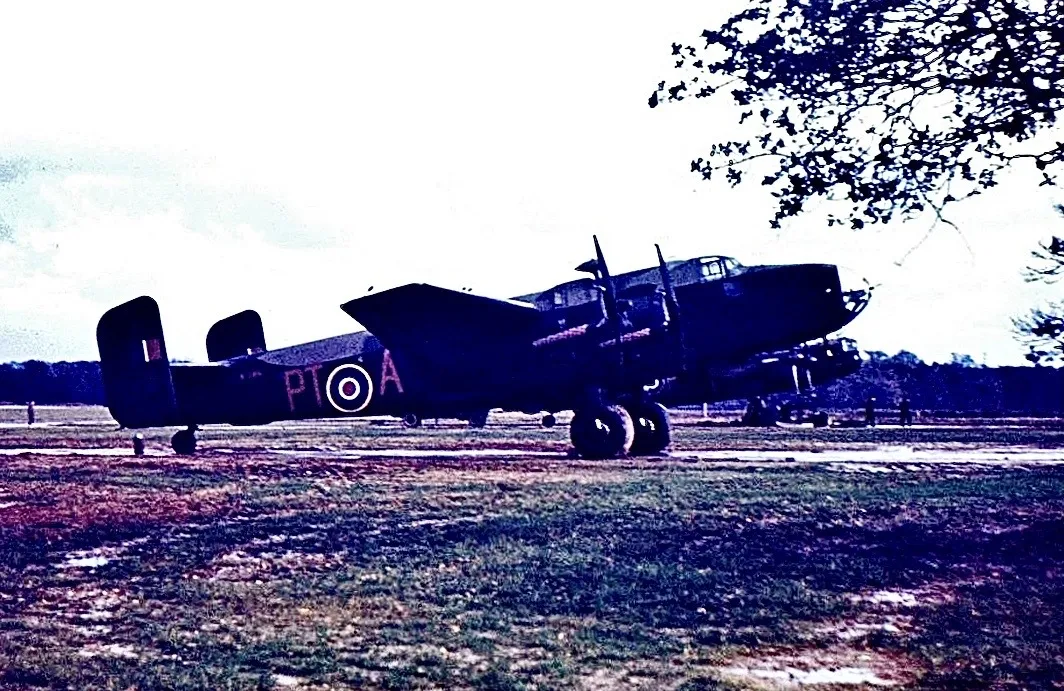
courtesy of Owen Merrick (Pilot Raymond Leonard's Great Nephew) and and Michael Baillargeon
✓ March 11 Training Flight, Halifax LW386 PT-A piloted by Warrant Officer Class 2 Raymond Leonard and with crew members Warrant Officer Class 2 Clarke Wilson, Flight Sergeant Alfred Warren, Sergeant Clifford Wheelhouse, Sergeant Paul Bourcier, Sergeant Robert Anderson and Sergeant Patrick Gough, participated in a short fighter affiliation exercise.
✓ March 24/25, Halifax LW692 PT-V, piloted by Warrant Officer Class 2 Raymond Leonard and with crew members Warrant Officer Class 2 Clarke Wilson, Flight Sergeant Alfred Warren, Sergeant Clifford Wheelhouse, Sergeant Paul Bourcier, Sergeant Robert Anderson and Sergeant Patrick Gough, set off for "Target Berlin". The aircraft took off at 1851 hours but was forced to return early due to undercarriage problems. It flew 2.35 hours, landing at 21:25 hours.
✓ March 26/27, Halifax LW590 PT-R, piloted by Warrant Officer Class 2 Raymond Leonard, bombed Essen. Crew members were Warrant Officer Class 2 Clarke Wilson Flight Sergeant Alfred Warren, Sergeant Clifford Wheelhouse, Sergeant Paul Bourcier, Sergeant Robert Anderson and Sergeant Patrick Gough. The aircraft took off at 2021 hours and flew 5.00 hours, landing at 0123 hours. Details of the Sortie stated "13 aircraft attacked target from 24,000 feet between 2202 and 2216 hours. Black smoke rising to 22,000 feet H/F lights to moderate in barrage form up to 24,000 feet. Weather 10/10th clouds in layers 8,000 feet".
March 30/31, Halifax LW692 PT-V, piloted by Warrant Officer Class 2 Raymond Leonard, bombed Nuremberg. Crew members were Warrant Officer Class 2 Clarke Wilson, Flight Sergeant Alfred Warren, Sergeant Clifford Wheelhouse, Sergeant JOB Masse, Sergeant Robert Anderson and Sergeant Patrick Gough. The aircraft took off at 2208 hours, flew 7:39 hours return and landed at 05:39 hours. Details of the Sortie stated "12 aircraft attacked, two returned early, between 01:15 and 0125 hours from 20,000 feet, Bombs 50 x 30, 100 x 4. Attack appeared successful with PFF, markers and flares rather widely spread. Several crews reported explosions. Weather: was 5/10th 10/10th thin at 20,000 feet with thin layer of clouds about 10,000 feet. Landed at Ford". Russell McKay told me (Bill Anderson) that he missed the Nuremberg Raid because he was getting his appendix out in Scotland.
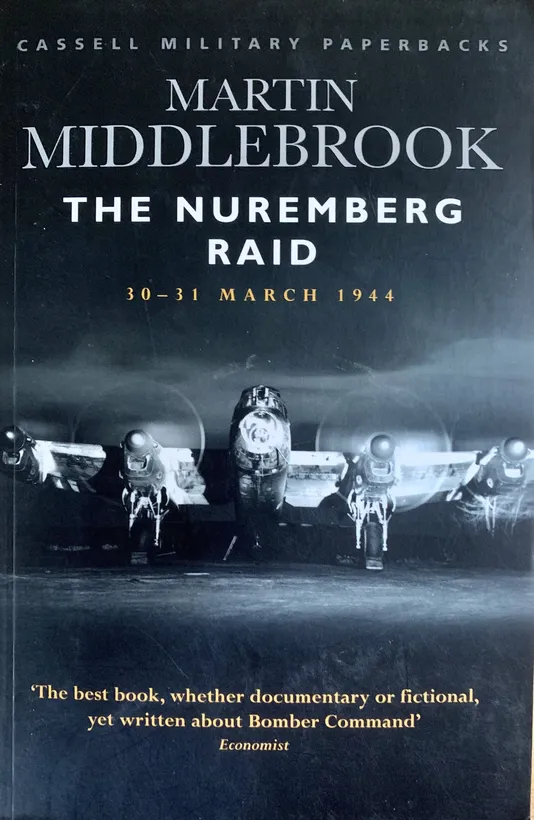
ISBN 0-304-35342-6
While the Bomber Command Operations Record Book, 420 (R.C.A.F.) Squadron, Form 541 states that the raid was successful, of the 782 bombers that took part in the raid, 96 bombers and 545 crewmen were lost, more than the total that died during the entire battle of Britain!
Martin Middlebrook, in his book "The Nuremberg Raid", states "Sir Arthur Harris, Commander-in-Chief of Bomber Command "¦ remained convinced that all-out attacks against the major cities would be the decisive factor in bringing the war to an end. He had anticipated that by 1 April 1944 his bombers would have caused in Germany "a state of devastation in which surrender is inevitable'. On the night of March 30, on what should have been a routine "maximum effort' raid to Nuremberg, Bomber Command suffered its heaviest loss of the war. Out of 779 bombers on the raid 96 were missing, while due to weather conditions over the target area Nuremberg was only lightly damaged."
In a letter home to his father, dated April 2/44, Anderson said, "I don't know where you got the idea that Luftwaffe was nearly dead. I got a kick when you said that ops over enemy territory would soon be just a ride. It sounds good to hear of terrific Nazi fighter losses but never underestimate your enemy. I think the Luftwaffe is a long way from dead, but I hope I am wrong. The boys sure took a beating the other nite by losing 97 kites, it was from fighters too. There was no flak at all. I know, I was there. We had a good trip and laid our eggs on the target ok. It was a lovely night. Moon light, that was the trouble, visibility was too good. It was so good that the Bomb Aimer got a pin point on the Rhine river and that's something. It gives me a thrill every time we cross the enemy coast you can see it so plain".
In his book, Middlebrook also quotes Anderson saying, "The only thing the Nuremberg Raid achieved was probably to raise morale in the Third Reich".
In another letter home to his father dated April 17/44, Anderson noted that while his aircraft was in the hangar getting its landing gear checked over, he stated that he "was looking it over and found a fair sized chunk of shrapnel sticking in her". He took out a screwdriver, dug it out and said that he would keep it as a souvenir and show it to you after the war. He then added, "We must have picked it up at Nuremberg" and also noted that he would be 20 years old in six days.
April 9/10, Halifax NA509 PT-B, piloted by Warrant Officer Class 2 Raymond Leonard, bombed Villeneuve St. George. Crew members were Warrant Officer Class 2 Clarke Wilson, Flight Sergeant Alfred Warren, Sergeant Clifford Wheelhouse, Sergeant N.C. Lewis, Sergeant Robert Anderson and Sergeant Patrick Gough. The aircraft took off at 2053 hours and flew 5.25 hours, landing at 0214 hours. Details of the Sortie stated "Bombs 6 x 1000, 8 x 500 M.O., Attacked target at 0004 hrs. from 15,000 feet. Markers, TK. Red and green both, also ground detail clearly visible. Bombing appeared to be well concentrated around T.I. A large explosion lasting for several seconds seen. George U/S. Monixa U/S. Good trip - target clearly visible".
April 10/11, Halifax LW692 PT-V, piloted by Warrant Officer Class 2 Raymond Leonard, bombed Ghent. Crew members were Warrant Officer Class 2 Clarke Wilson, Flight Sergeant Alfred Warren, Sergeant Clifford Wheelhouse, Sergeant JOB Masse, Sergeant Robert Anderson and Sergeant Patrick Gough. The aircraft took off at 2045 hours and flew 3.50 hours, landing at 0036 hours. Details of the Sortie stated "Bombs 9 x 1000, 6 x 500, M.G. Attacked target at 2251 hrs. from 13,000 feet. Some of the bombing seemed to be going to the south of the markers, but the raid seemed fairly good. P.F.F. were bang on time and the raid should be successful".
✓ April 18/19, Halifax LW692 PT-V, piloted by Warrant Officer Class 2 Raymond Leonard, bombed Noisy Le Sec. Crew members were Warrant Officer Class 2 Clarke Wilson, Flight Sergeant Alfred Warren, Sergeant Clifford Wheelhouse, Sergeant Paul Bourcier, Sergeant Robert Anderson and Sergeant Patrick Gough. The aircraft took off at 2104 hours and flew 5.25 hours, landing at 02:29 hours. Details of the Sortie stated "Bombs 6 x 1000, 9 x 500, M.C. Attacked target at 0000 1/4 hrs. from 15,000 feet PFF well concentrated. Large yellow explosion seen at 0007 hrs. PFF seemed bang on. Appeared to be a good shot. Friendly aircraft seen to blow up in front of us".
April 20, 1944 - Hit By Flak
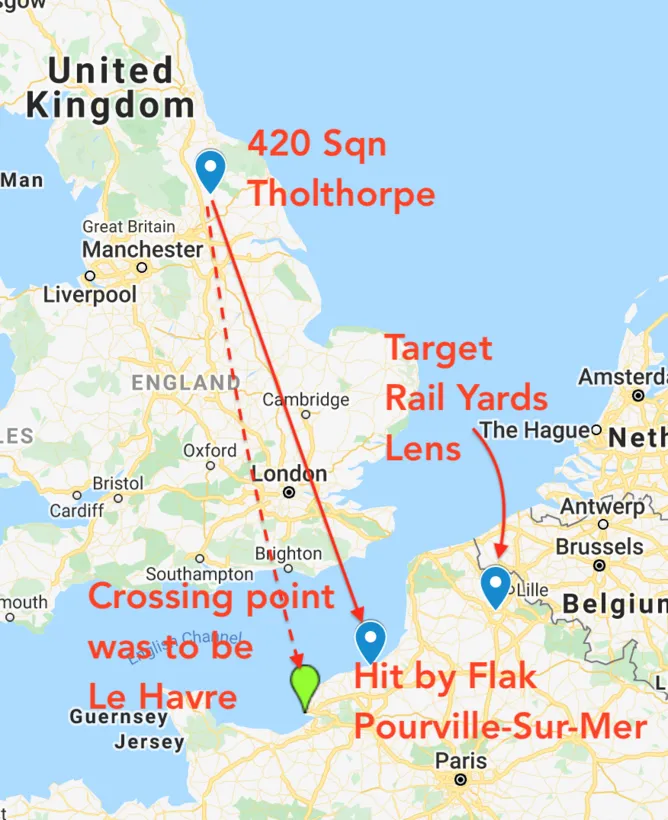
✓ April 20 1944, Halifax LW692 PT-V, again piloted by Warrant Officer Second Class Raymond Leonard and with crew members Warrant Officer Second Class Clarke Wilson, Flight Sergeant Alfred Warren, Sergeant Clifford Wheelhouse, Sergeant Paul Bourcier, Sergeant Robert Anderson and Sergeant Patrick Gough, took off to attack the rail facilities at Lens France. LW692 PT-V, carrying a bomb load of 9 x 1000 and 6 x 500 pounds of high explosives, was shot down that evening by flak. Details Of Sortie Or Flight notes state "Missing. Nothing has been heard of this aircraft since take-off".
Weather described by other crew as "Thin Cloud 6/10th to 8/10th tops 5,000 ft."
Of the 154 Halifax bombers that took off, LW692 was the only aircraft that failed to return that night. Robert Anderson and Paul Bourcier, the mid-upper gunner, were its only survivors.
Sergeant Robert Anderson described the event as follows:
"We flew down to south England and over the channel. Reached enemy coast 10 minutes early and off track, we passed over very near Dieppe. They threw up a lot of flak and we got 3 hits, the plane shuddered, slowed down and lost height fast. Port engines went on fire, spread to whole wing, engineer admitted it was hopeless, skipper said bale out.
I got to escape hatch after mid upper gunner and jumped after him, plane was diving very fast and had trouble to get out of slipstream. Saw the plane spiral down on fire and crash. I landed in the mouth of a small river (Scie River) near Dieppe, had to use my Mae West, not a scratch."
Sergeant Paul Bourcier's account stated:
"After taking off and setting course for Southern England and then the channel we got off course and reached the enemy coast ten minutes before time over Dieppe, which was about 20 miles off course, as Le Havre was the crossing point.
We were picked up by radar and we were hit 3 times by flak, causing trouble to port engines, the necessary measures were taken, but fire started, and spreading rapidly on the port wing, I was then given order to bale out, which I did and by doing so landed safely. Out of front hatch."
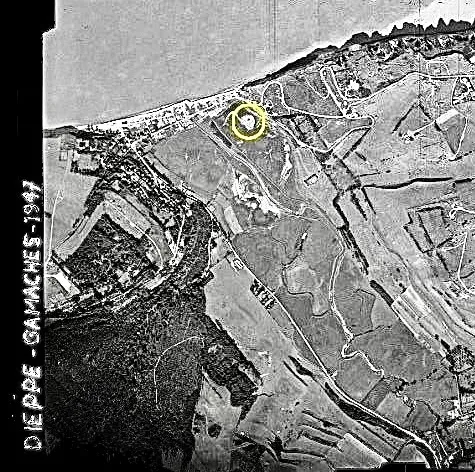
LW692 crash crater
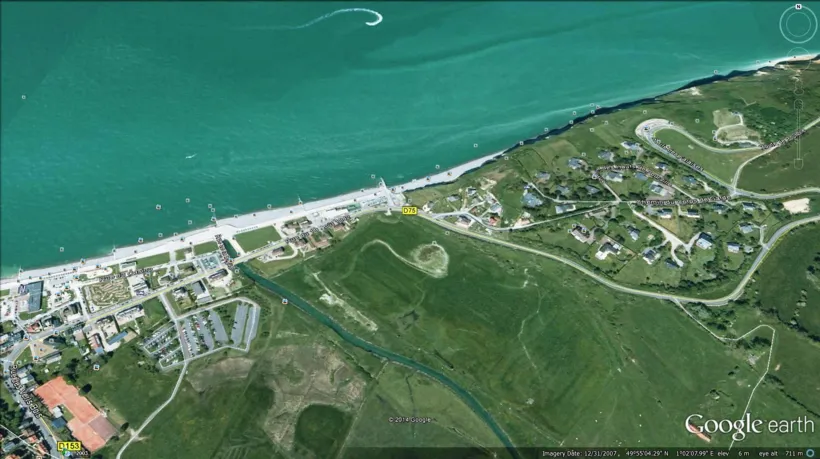
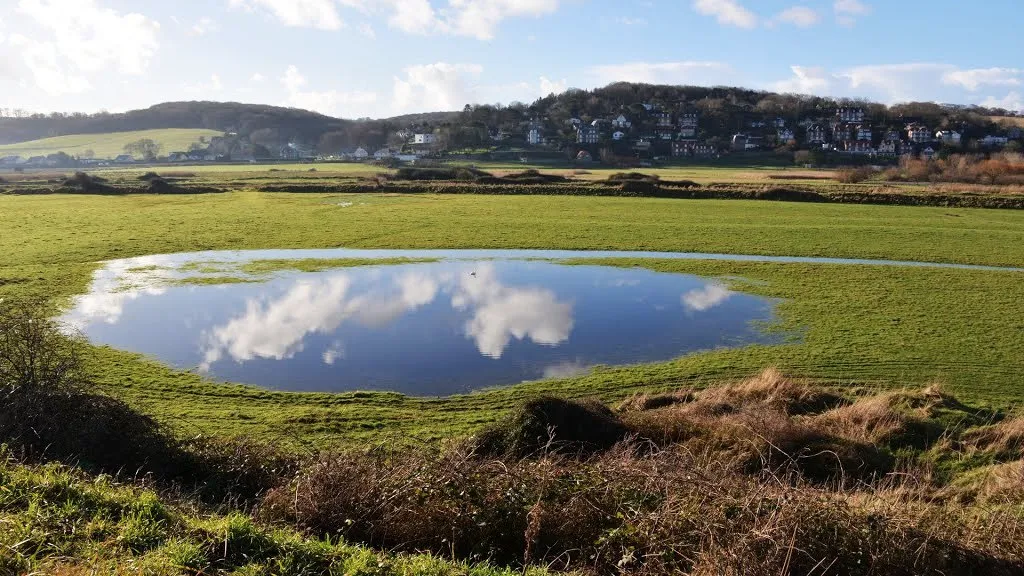
LW692 crash crater
![]() Returned Escape Evader Report on LW692
Returned Escape Evader Report on LW692
![]() Dieppe Newspaper article by Laurent Viton
Dieppe Newspaper article by Laurent Viton
A witness who spoke with French Researcher Laurent Viton, said that he saw the aircraft explode just over a marshy estuary of the Scie River at Pourville France. The crater that was left is not only visible in the 1947 aerial photograph shown below which was taken by the French Geographical Survey (Institute Geographique National), but remains visible today.
Laurent also stated "It couldn't be seen in 1944 as the area was flooded by the Germans to prevent an allied landing after the disastrous Jubilee (Dieppe) Raid in 1942 and as a forbidden area, locals were not allowed going close to the coast".
On June 28th, 1945, a letter was sent to Raymond Leonard's Father indicating that a Royal Air Force and Dominion Air Force Missing Research and Inquiry Service had been organized for the purpose of research and inquiry in liberated territories into the circumstances of aircrews reported as casualties. (see links below)
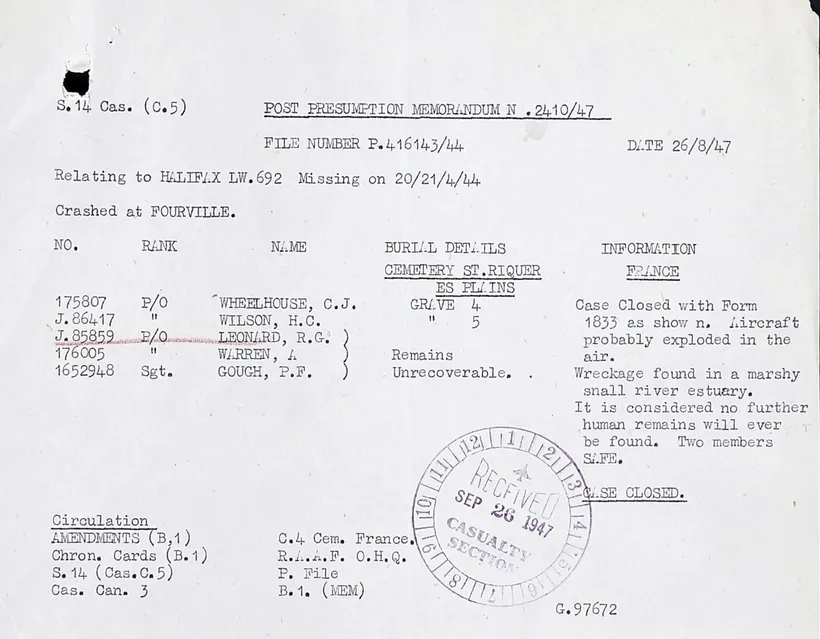
CASE CLOSED
On November 26th 1947, a letter from the Undersecretary of State, Air Ministry, London stated that the Graves Registration Service of the War Office found that the St. Riquier es Plains Cemetery to be unsuitable and on March 2nd, 1948, a letter was sent from the R.C.A.F Casualty Officer in Ottawa to Mr. Wilson confirming that his son had been re-interred in the Grandcourt British Military Cemetery, 19 miles East Southeast of Dieppe and that his son lies at rest in Row E, Grave No 5. (see links below)
PoW Stalag Luft 3, Sagan Germany (now Zagan Poland)
A Wartime Log for British Prisoners is a log kept by many PoWs.
- Dad stated in a June 4/44 letter home from Stalag Luft 3 "We Canadians had our picture taken the other day, a group from west Canada, Manitoba and three of us from Brandon who are here". Gord King, front row 4th from the left, was a participant in "The Great Escape", who I had the pleasure of meeting through my Dad. According to an article about King in the Edmonton Journal on November 11, 1999, "he was the 146th Allied airman to win a chance at freedom through the escape tunnel 10 metres below the prisoner of war camp in Germany. By a quirk of fate, he never had his chance in the tunnel before it was discovered. And by good fortune, he was not one of those who paid for the escape with their lives. "I was lucky I wasn't anywhere near getting out' ".
- Dad's Log also lists the names of numerous POWs from Australia, Canada, England, New Zealand, Scotland, South Africa, Wales and the United States that he met in Stalag Luft 3, including their rank, address and the type of plane they were in when shot down.
- The Last Mile To Luckenwalde from Wartime Log starting on page 69.
- On page 77, dated March 3, Dad writes "Max Schmelling was in the camp (Stalag III A) for about an hour today. He gave the boys his photo and autograph. Some senior officers were very annoyed". Max Schmelling was the former heavyweight champion. Schmelling article on page 25 is not original.
After capture, the Nazi's interrogate Bourcier and Anderson. A quick timeline is presented by researcher David Champion:
"Plane goes down, Anderson and Bourcier are picked up. From there they take a train ride to the Dulag Luft (Luftwaffe Interrogation) centre at Oberursel, north of Frankfurt. Most fliers spent between 2-3 weeks there. Treatment ranged from pretty decent to threats to a strange scenario where the Luftwaffe stripped you of all your clothes and locked you in a room with the heat turned up high. They had an interrogator there from Kitchener, Ontario who spoke better English than some of the Canadians there. When the Fatherland called he returned to Germany." I (Bill Anderson) have never discussed the interrogation with my father Robert Anderson. However, a 1945 newspaper article that I was reading, titled 1,600 Airmen Return, Most From Captivity, it says "Shot down by flak over Dieppe in April of last year, Flying Officer Bourcier and his friend Flying Officer Bob Anderson of Winnipeg were subjected to a severe quizzing by the Nazis at a Frankfurt interrogation centre. When they refused to talk, they were sent to Stalag Luft 3 in Upper Silesia".
Both Anderson and Bourcier were sent to the North Compound of Stalag Luft 3, Sagan Germany (now Zagan Poland), arriving shortly after 50 airmen were recaptured and murdered by the SS under the direct order of Adolph Hitler for their part in what became known as "The Great Escape".
![]() RAF interrogation Training Film
RAF interrogation Training Film
![]() Britain Defence Secret German PoW Interrogation Analysis
Britain Defence Secret German PoW Interrogation Analysis
While the letters and Postkartes home from Stalag Luft 3 were inspected and censored, they did describe basic day-to-day life in captivity. The letters home to his Dad during "ops" however, describe both the excitement and dangers encountered by bomber command crews, as well as the close relationships crew members developed, even if short lived. The latter further helps me understand why my Mother would often say that she had to hold and console him every November 11th as he always found that date to be an extremely difficult day.
![]() Stalag Luft 3, Sagan Germany (now Zagan Poland)
Stalag Luft 3, Sagan Germany (now Zagan Poland)
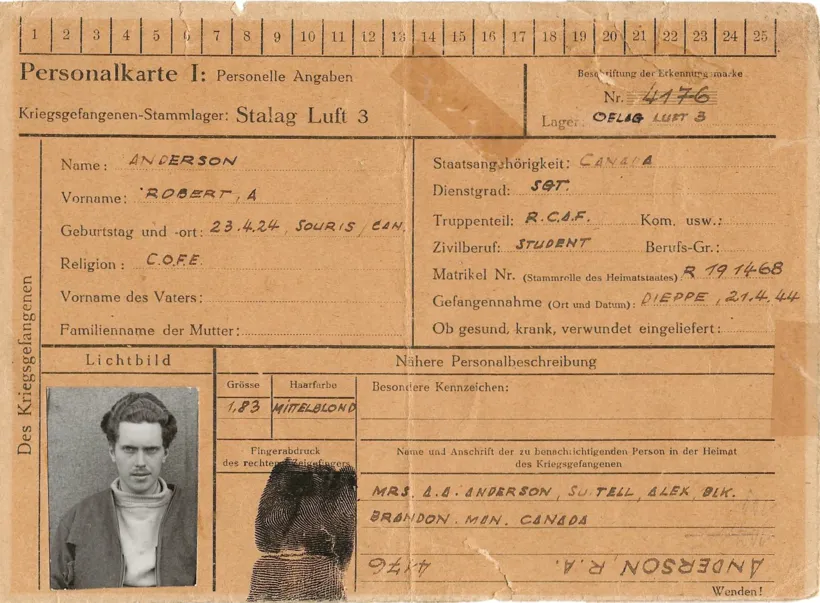
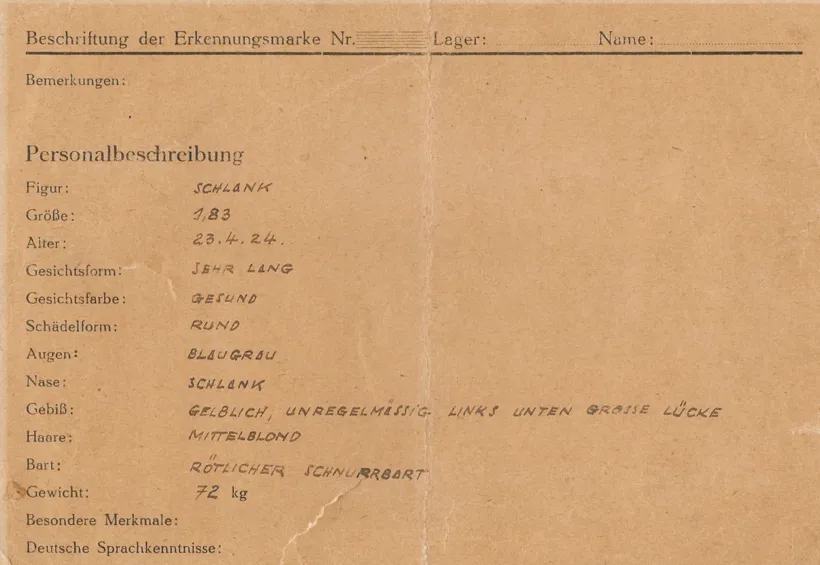
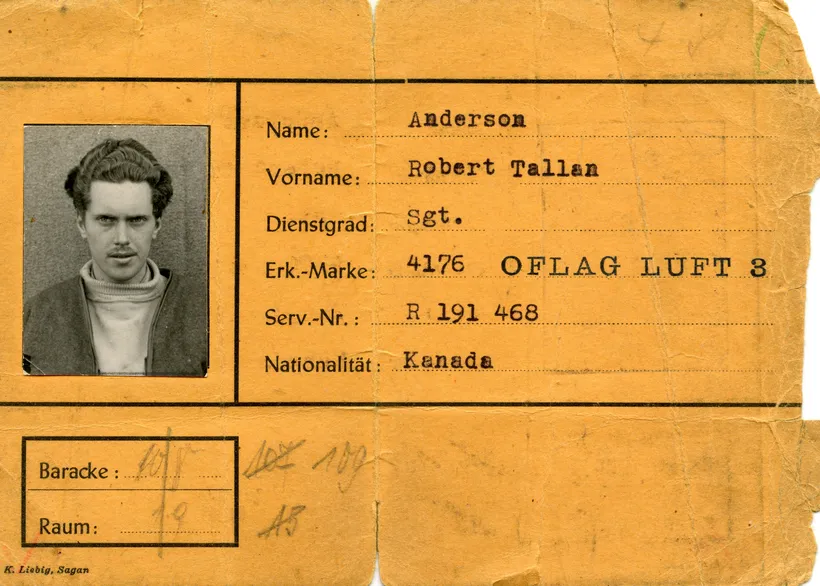
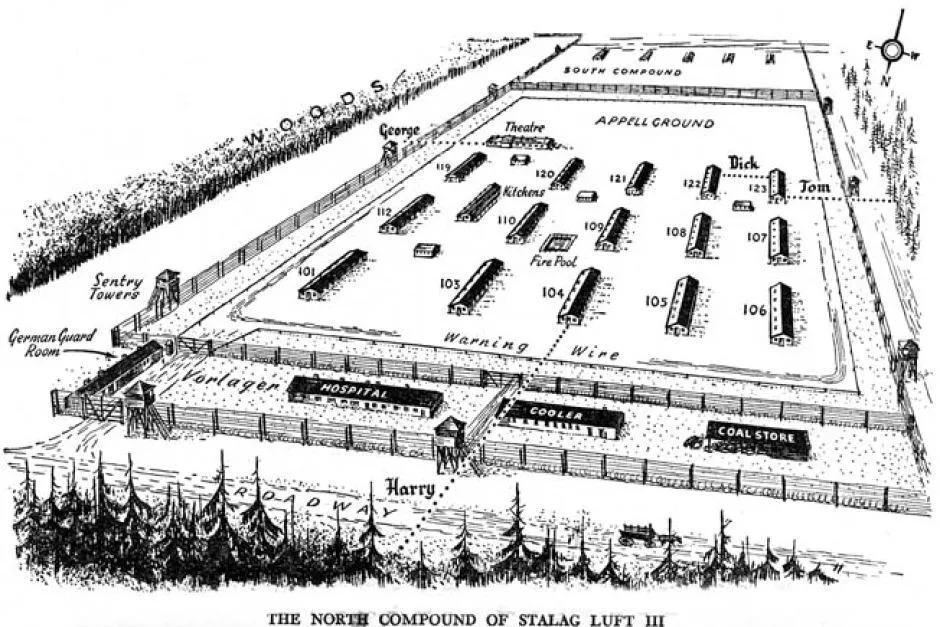
by Ley Kenyon author artist and POW in Stalag Luft 3
Marek Lazarz, Director of the Stalag Luft 3 Museum in Zagan Poland, states that Dad's ID card indicates that he was in building 108 room 19, then in building 107 room 15, and then in building 109 room unknown. Marek added "Sergeants usually lived in room #13, the room near the kitchen annex. You are probably wondering now why he changed the huts. There was no special reason of that. POWs had lot of freedom to operate within compound. Compounds were actually administrated by the POWs itself (by the senior officers, to be exact). So, it could be any reason why he changed the hut. Of course everything was supervised by the Germans and every action within compound was reported." Note: The "Great Escape" took place from building 104 out of tunnel Harry.
My Dad made the following statement on the loss of Halifax Bomber LW692 PT-V and crew members while a Prisoner of War:
"On the night of 20th/21st April, 1944 our aircraft was directly hit by flak near DIEPPE. The aircraft caught fire and the order to bale out was given. I was second to leave the aircraft. I was taken to YUETOT with Sergeant Bourcier. I identified the bodies of Flight Sergeant WHEELHOUSE and W/O WILSON and they were buried near Yuetot."
NOTE: In a March 7, 1945 letter to my Grandmother, the RCAF Casualty Officer stated "Since my letter of August 28th, 1944, further advice has been received from Overseas which states that your son, Robert Allan Anderson, who is a Prisoner of War in Germany, has been commissioned with the rank of Pilot Officer with effect from April 19th, 1944. His Officer's number is J92326. Notification of the promotion has been forwarded to the Department of External Affairs, Ottawa, for transmission to your son".
Then on May 1, 1945, the Canadian Minister of National Defence for Air, "By Command of His Excellency The Governor General" appointed Robert Allan Anderson to be an "Officer in Our Royal Canadian Air Force of Our Dominion of Canada from the Nineteenth Day of April 1944" to the "Rank of Pilot Officer".
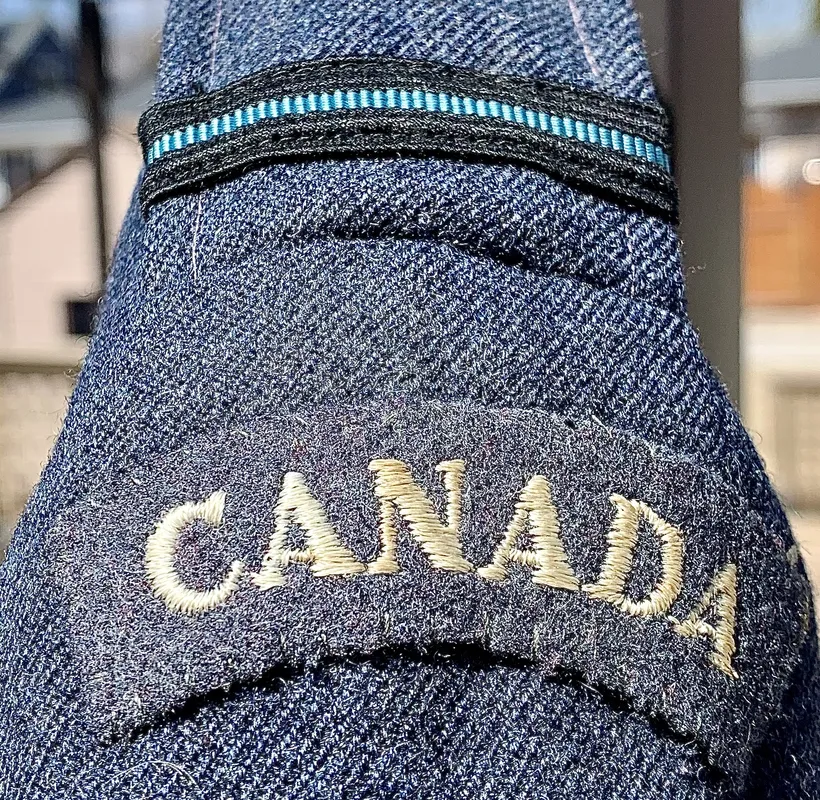
I have no idea as to when Dad learned about the promotion!
In his first letter home from Stalag Luft 3, dated 30/4/44, Dad writes "Dear Folks. Well how is all in Brandon? All is ok here and I'm not fooling. You must be glad to know I'm here and someday I'll come home alive and unwounded. "¦ Write to Mrs. Alex Bourcier Chateauguay Village Quebec eh, you remember Paul, well we're still together thank God. I guess we'll be pals till we die. The rest of the crew weren't so lucky. I only got a nose bleed when I bailed out. "¦ My biggest burden is worrying about you because I know you are worrying about me. My spirit is high and I can assure you I'll come home as young and wild as when I left." The letter was received July 20, 1944.
In a Postkarte home dated Oct 20/44, he told his Dad "When the parachute opened, my boots jerked off". When my Dad's sister Marie and her daughter Roxanne visited Paris many years later, Marie remarked that she had to walk down the Champs Élysées and under the Arc de Triomphe to be where her brother walked after capture with only one shoe!
In a December 13, 1944 letter, he says "In our room we have 5 English boys. 2 are Fleet Air Arm and have been down since early 1940, 3 are RAF prisoners from 2 to 3 years, there are 4 Canadians including Paul and myself W.O. Hal Lindlater from Vancouver shot down 3 days after us and W.O. Will Hamilton from Montreal a PoW since 42 plus 3 Americans shot down in July, they're swell guys".
See my Dad's Wartime Logbook for an original photograph of Manitobans in Stalag Luft 3 Source aircrewremembered.com for some background on each.
The Long March And Liberation
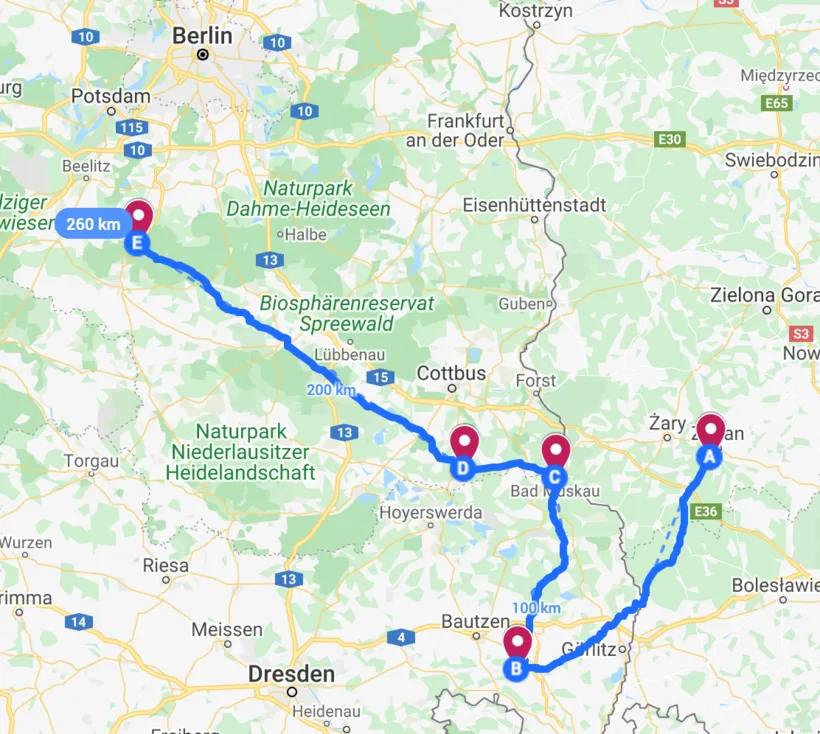
C Muskau (Bad Muskau) | D Spremberg | E Luckenwalde
As the Russians advanced towards Germany in 1945, Hitler gave the order to evacuate POW camps and move POWs closer to Berlin.
![]() Stalag Luft 3 Museum: The Long March
Stalag Luft 3 Museum: The Long March
"May 6, 1945 — Russians refuse to let Americans evacuate us, some trucks have gone back empty. Russians have posted guards who have shot at some of the fellows."
On May 7 1945, he nevertheless managed to "escape" his "new captors" by making his way to the American lines at Magdeburg.
On May 13 1945, he provided additional information on the tragic fate of WO/2 Clark Wilson, W/Op. Flight Sergeant Clifford Wheelhouse and F/E Sergeant Patrick Gough in a "Questionnaire For Completion By RCAF Returned Evaders, Escapers Or Prisoners Of War", in which he added "F/E Sergeant Gough's flying boot badly torn and bloody. German's told us they were all dead."
In his last letter home dated May 31 1945, he said "My old squadron is flying home to train. Paul, myself and nearly all RCAF POWs are on here." He then reiterated, "I will be home very shortly now. Again I say don't meet me down east or don't meet the trains. Let me come home and find you there. I'll wire telling you the day I'll be in. Till then, love Bob."
Earlier in April 1945, the 420 Squadron converted to Lancaster bombers and when hostilities concluded in Europe, it was selected as part of Tiger Force slated for duty in the Pacific and returned to Canada for reorganization and training. While my Mother told me that Dad intended to take part, I never had the opportunity to discuss it with him. Everything changed however with the sudden end of the war in the Pacific.
LONG MARCH (TORTURE MARCH: Bob Anderson's title)
The Last Mile To Luckenwalde
Saturday January 29, 1945 — 9pm
| Page | Writing |
|---|---|
| 83 | It started when some one in the passage shouted "be ready to leave the camp in 1 hour." This wasn't entirely unexpected but it was entirely unwanted. A day or so previous the Russians reached Steinan about 35 miles away on the Oder. And we were hoping they'd soon reach Sagan and us, but such was not the case. We hurried by packed our kit and as many cigarettes as we could carry. Still there were millions in the camp. Thousands were burned or rendered useless in other ways. The amount of clothing, pictures, souvenirs, food, etc. left behind was colossal. Despite ½ parcels, our cook had a goodly supply in the cupboard which we split 11 ways giving each man about 15 lbs. of |
| 84 | food. Then we were told we weren't leaving for another hour, so we made a sleigh for our kit. Another hour went by and still no move so we cooked some meat we got from the cook house and had a real good feed. Then I went and visited my friends in various huts. Every one was in high spirits although I don't know why. Then in the west camp of over 2,000 Americans moved out. And then about 2am, amid great confusion and flap, we left our camp. First we went to the parcel store and got a Red Cross parcel for each man. To get these on our sleigh we had to throw a lot of clothing off. Then we pulled our greatly over loaded sleigh out onto the road and started on our |
| 85 | way. It was a clear, cold winter nite, and just right for sleighing. In the moon light you could see thousands of PoWs ahead and many more were still to come. Everyone had a sleigh hastily lashed together out of hockey sticks and red cross boxes or anything at all from chairs, tables or beds. Soon the circuit lights of the camp began to fade in the distance and somehow I sort of wished I was back there, I sort of figured we might have a rough time ahead but I didn't know the half of it. The first thing I noticed on the way was the great amount of clothing and food that was being discarded, many sleighs had broken and the follows had left all except blankets, some food and cigarettes. I noticed many Red Cross parcels |
| 86 | torn open, the biscuits, sugar, jam and chocolate removed and the rest ditched. A lot of civilians we're out on the road. Asking for cigarettes and picking up what the fellows had discarded. A lot of them were women, the first I had seen for 10 months, and some of the boys, years. We marched all nite, stopping occasion[a]lly to rest. The odd truck went past us and a lot of trucks and buses all going east, laden with white clad troops. All nite we marched through forrest country, and dawn found us in a small town where we rested a while and ate some breakfast of frozen spam or biscuits. We took the opportunity of this |
| 87 | stop to lighten our load and 7,000 cigarettes, clothing, a pair of skates and other things were discarded, to the delight of German "Civvies". Then we marched out of the town and onto a flat open road. The wind was very bitter and you had to march to keep warm. One of the Guards told us we had only a few more miles and we would have a rest with all comforts. On, and on we went. It was good sleighing but we were getting a bit tired. We passed village after village. The boys with sleighs were doing ok except the odd one was falling to bits and they had to shoulder their kit and also ditch a lot of weight. The boys who had left with all their stuff on their backs, |
| 88 | were getting pretty tired and I noticed many of them stopping to rest and come up with the next party behind us, for we were stretched out for miles. We were doing all right with our 1 man sled (it was the biggest I saw on the march). We took turns pulling it so ½ the time we were just walking empty. Most of the guards carried their own kit and it sure looked heavy, many of them looked ready to drop and they weren't making the trip as well as the average PoW. Before the trip was finished I noticed some of them sharing the same sled as PoWs. About noon we reached the out-skirts of the town we were to rest at. I believe the name of it was HALBAU. We entered the town and pulled up in a big market square, which was then |
| 89 | full of PoWs but in 1/2 hour later had 5 times as many in it. The comforts we got there consisted of hot water. So we sat in the snow, made a hot brew, and ate a Spam sandwich and some biscuits from our parcel. It was too cold to rest and impossible to get inside anywhere so we just hung around. I went through the crowd, looking for friends. I found them all doing ok, a lot of bartering was going on with the Civvies who were very friendly towards us. Such things as bread, and sleighs were bought for cigarettes. (You could buy anything for cigarettes.) Then we were told we would spend the rest of the day there and night in barns, theatres etc. which sounded very good. Some of the boys even got in buildings and |
| 90 | to sleep when we had to leave the town because refugees would be coming in. So we pulled out very foot sore and weary. On the out skirts of the town we passed the west camp who were resting as best as possible in the snow. Everybody's feet were soaking wet and the snow was loose, about 3" deep. You could see the snow melting on your boots from the heat of your feet, it was very miserable. It was now very cold, snowing and blowing and we marched till dark and stopped in an open place just outside a small town. We stood there for 3 hours waiting while they found barns for us to sleep in. That was the worst 3 hours I'd ever spent. We had been out side some 18 hours with very little to eat and marched |
| Page | Writing |
|---|---|
| 91 | about 38 kilometres with pack so some of the boys were pretty tired. Final(l)y we got into a barn. It was pitch dark and sever(e)ly cold, so we just lay in the hay, pulled our blankets over us and tried to sleep. I half slept for several hours but it was too cold. I don't think anybody slept well, many froze toes and feet. Final(l)y came the dawn, of the worst nite I ever spent or want to spend. I put on dry socks which were wet in 5 minutes because of my boots. We ate a breakfast of frozen meat (Spam) biscuits, jam. And got out onto the road by 8am and away again. By now every step was misery. The previous day's march and the cold, restless night, and |
| 92 | every muscle and joint ached[.] However, every body was in the same boat. We marched till noon and ate dinner in a fair sized town. In this town we bought a lot of bread off the Civvies, a lot of fellows bought sleighs. Shortly after we pulled out of this town it started to snow and blow and continued all afternoon. We marched a very long time with no rest and many of the boys were all in. It was hard enough to walk alone, much less pull a sleigh under the rate the Guards set up. Still the kilometres ticked by. At every little village a dozen or so dropped out and sat by the road as the procession of PoWs passed wearily by. |
| 93 | Finally we stopped to rest just opposite an army barrack. They were ok to us and gave us hot water and sold us bread. Our stay here was for too short and we hit the road again. As time went on more and more fell out and many who could not keep up walked slower. And I saw quite a few fellows who fainted and dropped by the side with a friend who stayed to help him. These ones were picked up by wagons much later on and many suffering bad frost bites. One of the boys in our party was ill and could not take his turn on the sleigh. It was now getting dark. And the prospects of spending this nite like the last one didn't make the boys |
| 94 | any happier; The towns were full of refugees as well who had to have a place to sleep. All we longed for was warm, dry floor with lights. It was after dark when we pulled into the town of MUSKAU where we were to spend the night. We were near the end of the train, so it was some time before we got a place to stay, so we just hung around on the street in shade of building. Many of the fellows chatted with civilians and they seemed as fed up as we were. The Canadian G/C Wray, walked up and down assuring us that we had good quarters for the nite. About 9pm we pulled |
| 95 | up before a large building and about 300 of us got in it. It was just what we desired. It was a riding school, one large room well lit, heated and straw on the floor. It smelled strongly of manure but no one minded that. Our party got settled in a corner and we made our beds on the straw. My blankets were full of hay from the previous night but I cleaned them fairly well. It was sure good to get to bed and we all slept very soundly. Next day we real[l]y got organized (Tues. 30 Jan), we got hot water several times a day for brews. We also got about 2/3 of a Red Cross parcel and a loaf of bread per person. We were in this town for 4 days, during which it got very |
| 96 | mild and all the snow went. The first day all the Americans left us for NURNBERG. and we said good bye to some fine friends. Then the rest of the north camp pulled out for SPREMBERG. About ½ of us stayed behind without transportation. We were very comfortable in the barn, We were on an estate owned by a GRAPH VON ARNHEIM supposed to be the third richest man in Germany. He was ok to us. There were some guards around who seemed as sick of the war as we were. We had a lot of liberty here, many of the boys wandering down town. We went down town with a guard to a shoe shop and got some apples, onions etc. the owner of the shop had a son who was a PoW in the USA. Then |
| 97 | one morning we got transportation and went over to Spremberg. The road was a solid mass of refugees and PoWs, most of the PoWs were Americans. There was no snow and all kit had to be carried, we pulled into a big military camp, got a meal and marched down to the train, loaded into box cars found we were going to Luckenwalde 30 km south of Berlin, traveled all that nite & next day and arrived at 1am. Next mor[n]ing (Feb 5) marched up to the camp about 2 miles, had a search and sent to quarters, very poor ones at that; about 170 men to a room. Got to bed at 6am a very tired and unhappy crowd. |
Life at Lukenwalde (Stalag III-A)
| Page | Writing |
|---|---|
| 74 |
FEB 19, 1945. STALAG III A. LUKENWALDE. GERMANY. 30 miles South of BERLIN. DAILY MENU. (NEVER VARIES) LUNCH 12P HOT BREW. |
| 75 |
Home food was a very common fantasy among PoW's A Wartime Log by Art and Lee Beltrone
RESOLUTION
I'M HAVING THIS SNACK WHEN I ARRIVE IN CANADA.
FRESH WHITE ROLLS. HOT.
1-LARGE MEDIUM STEAK.
WITH 3 FRIED EGGS ON TOP.
FRENCH FRIED POTATOES.
DESSERT-
LARGE ICE CREAM. FRUIT.
SUNDAE.-WITH LOTS OF MARSHMALLOW & NUTS
CHOCOLATE BISCUITS & MILK.
ROLL ON THE RUSSIANS AND HELP ME GET THIS FOOD.
|
| 76 |
"today is our day to rummage in the garbage for potatoes cabbage etc discarded by the cookhouse"
SPECIALTIES, AT STALAG IIIA
FEB 10. A PICTURE SHOW. A SILENT GERMAN SHORT ON ANIMAL LIFE. A "SILENT "LAUREL + HARDY' FILMED IN 1924. TOTAL 1 HR. FEB 21 AS A GIFT FROM THE NORWEGIANS. WE GOT 1/5 OF A DANISH RED CROSS PARCEL PER MAN. VERY GOOD AND VERY LITTLE FEB 23 BECAUSE OF SHORT BREAD ISSUE WE GOT AN EXTRA BOWL OF BARLEY AT 4 P.M. VERY ENJOYABLE. FEB 27 TODAY IS OUR DAY TO RUMMAGE IN THE GARBAGE. FOR POTATOES CABBAGE, ETC. DISCARDED BY THE COOKHOUSE |
| 77 |
MARCH 3 MAX SCHMELLING WAS IN THE CAMP FOR ABOUT AN HOUR TODAY. HE GAVE THE BOYS HIS PHOTO + AUTOGRAPH. SOME SENIOR OFFICERS WERE VERY ANNOYED. MARCH 8 TODAY EVERYONE GOT AN AMERICAN RED CROSS PARCEL AND PROSPECTS OF MORE ARE VERY GOOD. I'VE NEVER SEEN THE BOYS SO HAPPY. EVERY BODY IS EATING ALL HE WANTS WHETHER WISELY OR NOT AND SMOKING TOO. FOR THE FIRST TIME IN OVER 6 WEEKS OUR STOMACHS ARE FULL AND IT SURE FEELS GOOD. APRIL 1ST (EASTER SUNDAY) HAVE RECEIVED RED CROSS PARCELS REGULAR AND THIS CAMP IS SURE A DIFFERENT PLACE. COMBINED WITH GOOD WEATHER AND NOW THE WEST FRONT IS MOVING THINGS ARE SURE A HELL OF A LOT BETTER. |
Liberation (April 1945)
| Page | Writing |
|---|---|
| 78 |
APRIL 21. The Russians are very close. All the guards have disappeared, fences are being cut down and prisoners running all over and there's great panic and excitement in the camp. Guns are booming on 3 sides of us. Some very close also I've been shot down a year today. APRIL 22 6 A.M. Awakened by cheering, went out side and saw a Russian armoured car with Russian officers in the camp, some Russian planes flying around too. APRIL 23. my 21st Birthday, still a lot of fighting around here. |
| 79 | A JU 88 fired into the camp last nite and scared everyone. Ate very well today Thanks to Russians. April 26. Went to town today but too much fighting so came back. Eating very well. The Russians are sure pushing in the food. German troops are coming up to the camp to surrender to us rather than the Russians. April 29. Went for a walk from the camp saw dead Russians and Germans, lots of abandoned equipment. A knocked out tank and 2 F.W. 90's. Passed through several villages. Life for civilians there was very poor. May 1st Still a lot of fighting around here mostly at nite. The woods are full of Germans, half |
| 80 | starved who want to get to American lines to surrender. No definite news of going home yet. The boys are very fed up and many walking to our lines 25 miles away, despite the threat of court martial for leaving camp. May 2. A big battle just out side the camp last nite, and a restless night inside the camp. This morning it was announced that the Germans in this area have capitulated. 120,000 were taken prisoner and 60,000 killed. May 4 hundreds of fellows are taking off for our lines. In a few days there will be no one here. 4P.M. 4 of us were ready |
| 81 | to leave camp tomorrow morning but 2 jeeps and 2 armoured cars (American) just came in and we're supposed to leave by truck tomorrow so I guess we'll slay. (The cars were covered with prisoners who they met walking away and brought them back to camp). May 6 Russians refuse to let Americans evacuate us, some trucks have gone back empty. Russians. have posted guards who have shot at some of the fellows. May 7. I left camp today and caught an American truck which took me to American lines at MAGDEBURG. For the first time I real[l]y feel free. |
| 82 | MAY 8. Hitch hiked to an airfield south of Hannover; living with Americans and being treated like a king; flew in a DC.3 to Rheims. MAY 10. got a Lancaster from Rheims to Tangmere (south England) landed 1.P.M. taken to Bournemouth. |
Manitobans in Stalag Luft 3 by Dave Champion at aircrewremembered.com.
|
R E F E R E N C E |
Official Correspondence On The RCAF Crew Members Who Died In the LW692 Crash (source Ancestry.ca)
|
